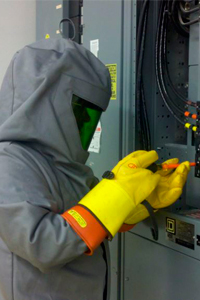Electrical Safety – Workplace Safety Reminders
‘Workplace’ covers a broad spectrum of working environments. Office buildings, industrial plants, construction sites, offshore oil platforms, underground mines, and retail businesses are a few examples that illustrate the span of what can be considered the workplace.
While the working environments differ, they all depend on electricity and electrical systems for energy, control, communications and data for virtually every aspect of operations.
Electrical accidents can and do happen in all workplace environments, although the frequency or severity may vary.
The following list of safety reminders is a brief compilation of generally accepted practices and should be adapted or modified to address the unique aspects of your working environment, your company policies, and local and/or state and Federal codes.
The intent of this list is to stimulate your thinking on what are the important electrical safety considerations for the people in your workplace.

Electrical Safety Principals –
When planning and performing work on electrical systems and equipment, keep these principles in mind:- Plan every job
- Think about what could go wrong
- Use the right tools for the job
- Use procedures, drawings and other documents as tools to do the job
- Isolate the equipment from energy sources
- Identify the electrical shock and arc flash, as well as other hazards that may be present
- Minimize the hazard by guarding or establishing approach limitations
- Test every circuit and every conductor, every time before you touch
- Use personal protective equipment (PPE) as a last line of defense in case something goes wrong
- Be sure you are properly trained and qualified for the job
Working On or Near Energized Equipment
- Treat de-energized electrical equipment and conductors as energized until lockout/tagout, test and ground (where appropriate) procedures are implemented.
- Work electrical equipment and conductors de-energized unless your employer can demonstrate that de-energizing introduces additional or increased hazards or is unfeasible due to equipment design or operational limitations.
- Lockout/tagout, and ground (where appropriate) before working on equipment.
- Wear protective clothing and equipment, and use insulated tools in areas where there are possible electrical hazards.
- De-energize and visibly guard (where possible) whenever contact with uninsulated overhead power lines is possible.
- Check and double check the safety regulations when a ladder or parts of any vehicle or mechanical equipment structure will be elevated near energized overhead power lines. Call your local electric utility for assistance. People standing on the ground may be particularly vulnerable to possible injury.
Cord Powered Equipment and Tools, Cords, and Temporary Wiring
- Protect flexible cords and cables from physical damage.
- Keep slack in flexible cords to prevent tension on electrical terminals.
- Check cords for cut, broken or cracked insulation.
- Make sure the insulating qualities of a splice are equal to or greater than the original cord.
- Extension cords are for temporary use. Install permanent wiring when use is not temporary.
Equipment and Tool Grounding
- Verify that all tools and equipment are grounded.
- Water, electrical equipment, and power cords do not mix! Use GFCI protection in wet or damp environments.
- Ground exposed parts of fixed equipment that could become energized.

Other Considerations
- Verify location of all buried or embedded electrical circuits before digging or cutting.
- Determine the reason that a fuse operated or circuit breaker tripped before replacing or resetting.
- Know where your over current devices are (i.e. circuit breakers and fuses) so they can be easily and quickly reached in case of emergency.
- When replacing lamps and bulbs, verify replacement matches fixture requirements.
- Adapt this list of reminders to fit your working environment!
- Establish a written electrical safety program for implementing the above.